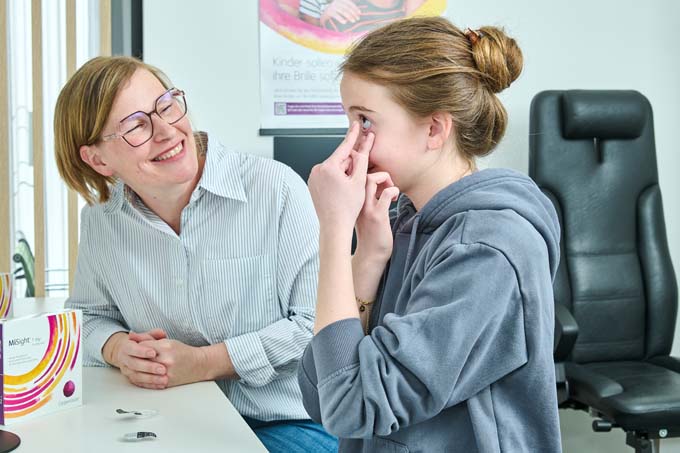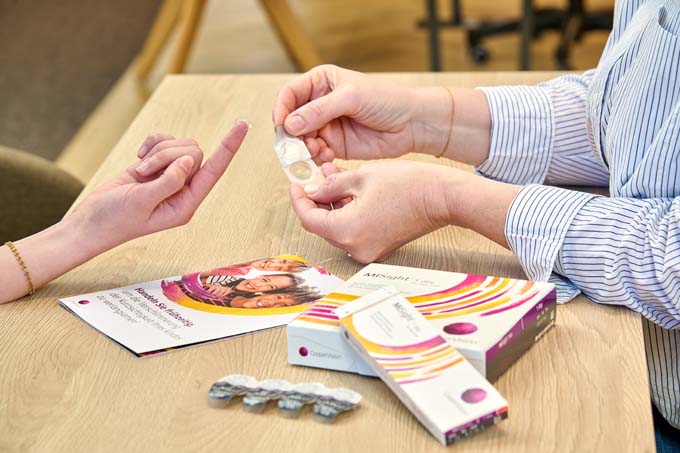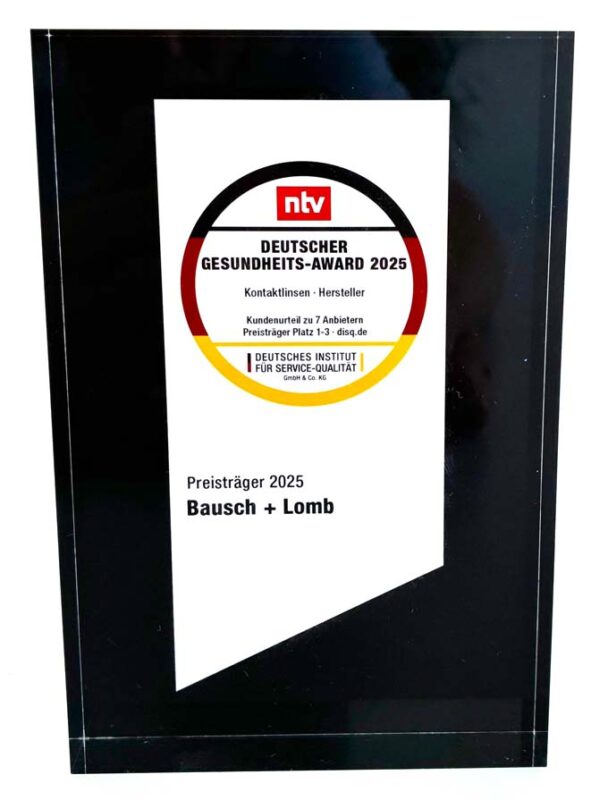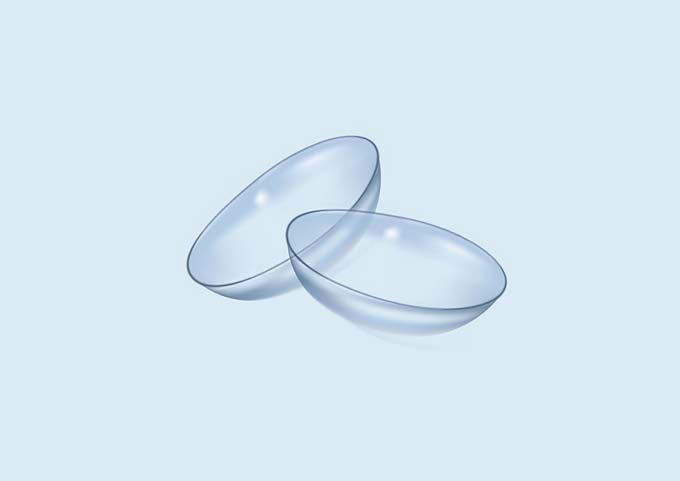Contact lenses in myopia management
Ms. Petra Zapsky is a state-certified optician and master optician as well as a Master of Science in Clinical Optometry. She has been responsible for Professional Affairs and Myopia Management at CooperVision since October 2016.

Ms. Zapsky has been passing on her knowledge in training courses, webinars and conferences for more than 25 years. In June 2017, she played a key role in the launch of MiSight 1 day disposable contact lenses in the DACH region. The aim is to train eye care professionals in the safe use of MiSight 1 day and to show them that children with myopia deserve evidence-based treatment for a life with better vision. In conversation with Ms. Zapsky, we also received further information on myopia management with contact lenses.
Basics and relevance
Ms. Zapsky, why is the topic of myopia management - especially for children and adolescents - currently gaining so much importance?
Studies show: Children are becoming short-sighted earlier and earlier, with short-sightedness now affecting almost one in three children worldwide. The reasons for this are mainly due to changes in living conditions. Children today generally spend far too little time outdoors and much more time in front of screens, cell phones and the like. It is therefore important for parents to pay attention to their children's eye health at an early age, as undetected short-sightedness develops quickly, especially at a young age, which can lead to significant impairments in the child's life. In the worst case, there is a risk of serious eye diseases later in life. Therefore, as called for by the World Council of Optometry in 2021, myopia management should be the standard of care.
What role do contact lenses play compared to other methods?
Contact lenses can generally be an attractive alternative to glasses, and not just for children. Contact lenses are practical, do not restrict children's freedom of movement and do not change their appearance. This is not only practical in everyday life, but also in leisure and sporting activities. Studies also show that children feel more socially integrated when wearing contact lenses. A huge advantage of contact lenses is that, unlike glasses, they are not simply taken off by the child and put to one side, because once they are on, they stay where they belong until the evening, invisible on the eye.
Contact lenses in myopia management
What types of contact lenses are used specifically to manage the progression of myopia (e.g. Ortho-K, multifocal lenses)?
We manage myopia by trying to inhibit its progression as much as possible. Many products are used for myopia management, not only in contact optics. However, it is important to distinguish whether these are specifically approved for this purpose (on-label) or are used without approval (off-label).
The MiSight 1 day is a product that has even been approved by the FDA for this purpose. Thanks to their ActiveControl technology, they create a so-called peripheral myopic defocus, which can inhibit the length growth of the eye. Studies show that they can reduce the progression of myopia by an average of up to 60 % over three years.
Orthokeratology contact lenses (Ortho-K) are dimensionally stable contact lenses that are worn overnight and shape the cornea in such a way that no visual aid is required during the day. Special designs in the Ortho-K range also create a peripheral myopic defocus, which can slow down the progression of myopia.
Some multifocal contact lenses also show a reduction in myopia progression of 25-72 % in studies. However, as these are contact lenses for presbyopes, their use is not officially approved for myopia management, so their use is off-label.
What is the physiological effect of these lenses on the eye and myopia development?
The physiological effect of contact lenses in myopia management - in particular MiSight 1 day disposable contact lenses and Ortho-K lenses - is based on targeted influencing of the focus on the retina in order to slow down the axial length growth of the eye.
The active principle of MiSight 1 day disposable contact lenses is peripheral myopic defocus, which is effective for as long as the contact lenses are worn.
The operating principle of Ortho-K lenses (dimensionally stable night lenses) is based on a peripheral defocus caused by a temporary reshaping of the cornea.
Why does the principle of myopic defocus work?
It is assumed that the retina reacts to blurred peripheral images with a growth stimulus. This stimulus is suppressed by deliberately shifting the peripheral focus in front of the retina. The eye "learns" that it no longer needs to grow, which slows down the progression of myopia.
Are there differences in effectiveness between the different types of contact lenses?
All three methods are effective, but MiSight 1 day disposable contact lenses are particularly suitable for children who prefer a simple, hygienic solution with soft disposable lenses. MiSight 1 day is also the only CE and FDA-approved contact lens for myopia management in children and adolescents. Ortho-K is ideal for children who do not wish to wear a visual aid during the day and is particularly effective for low and moderate myopia. Multifocal contact lenses are a flexible option, but not all are officially approved for myopia management.

Practical implementation
How does a typical fitting of such contact lenses work?
Fitting the MiSight 1 day is no different from fitting any other disposable contact lens. First, a current, needs-based refraction is carried out and the BSG is calculated and measured from this. Of course, an exact slit lamp microscopy and keratometry or topometry are carried out before the fitting. The appropriate MiSight 1 day is selected and fitted on the basis of the values determined. In the second step, after a familiarization phase (tolerance test), the fitting is checked, any necessary changes are made and in the third step, handling is practiced with the child. Parental involvement may be helpful here, especially at the beginning. When the MiSight 1 day is dispensed, the optician will explain not only how to use the contact lens but also the hygiene of the contact lens and what needs to be taken into account when wearing it. Ideally, the child should be able to carry out the procedures (at least removing the contact lenses) as independently as possible. It should not be forgotten that the MiSight 1 day must be worn for at least 10 hours on at least 6 days to ensure effectiveness. A follow-up appointment is also arranged. This should usually take place 14 days after the fitting.
At what age can you start using it?
It is important to start fitting as early as possible after myopia has been diagnosed. Children from the age of eight are able to put on contact lenses. We have a little rule of thumb: If a child can tie their shoes, then they can also handle contact lenses.
What requirements do children or teenagers need to meet to be suitable for these lenses?
Of course, it largely depends on the maturity of the children, their sense of responsibility and how adept they are at handling contact lenses. However, most of them like contact lenses and learn how to use them very quickly.
How much effort is required for control, hygiene and aftercare?
The effort involved is no greater than for any other contact lens. The optician will provide information on hygiene and aftercare. We provide detailed handling instructions that also inform parents and children about correct handling. As with other contact lenses, follow-up checks should take place every 1/2 year.
Experience and patient perspective
What feedback do you receive from parents and young patients?
Our customers tell us that parents are often skeptical beforehand when it comes to contact lenses for their children. However, when they see how enthusiastic their children are after the fitting, their enthusiasm usually spreads to them. They are often downright overwhelmed by how well their children cope with the contact lenses.
Challenges and risks
What typical difficulties or risks arise in practice?
Typical difficulties could be, for example, a feeling of dryness or a foreign body sensation, which may occur initially. However, these usually disappear after a short time. As they are disposable contact lenses, they are generally easy to handle, but younger children may be unsure when putting them on and taking them off or may make hygiene mistakes if they have not washed their hands thoroughly. A lens that is not optimally centered can also impair the effect of myopic defocusing. This can be a particular challenge for children with large pupils or restless gaze. It is also important to know that astigmatism is not corrected by the lens. The 20 % rule should be applied here. Our MiSight 1 day is considered safe and well tolerated.
How do you deal with complications or discontinuation of treatment?
If myopia management is initially rejected as a form of treatment, we as specialists should proceed with good information and point out regular myopia checks, at least every 1/2 year, because what plays into our hands is time. Because even if the psychological strain may not have been there at the beginning, it will soon be there after a few months when parents notice at the check-up appointment that their child's short-sightedness has continued to decrease, i.e. their vision has become worse. If myopia management with the MiSight 1 day is not as successful as desired, compliance should be checked first. Is the child really wearing the contact lenses as required or are the wearing times shorter? This should then be readjusted. Sometimes it may also be necessary to increase or change the form of therapy.
Future prospects
What developments or innovations do you expect in the field of myopia management over the next few years?
We anticipate that myopia management will become increasingly well-known among the general population and that more and more parents will demand this form of therapy. We are ready with a comprehensive portfolio of market-leading products and brands that enable eye care professionals to counteract childhood myopia. These include approved products such as disposable contact lenses, Ortho-K contact lenses and special lenses. We are also hoping for a rethink on the part of ophthalmologists and closer cooperation between the medical profession and the optical industry. That would make a difference.
Do you think that contact lenses will become the standard solution?
We are firmly convinced that this will happen. Contact lenses will play a central role in myopia management - especially for children with progressive myopia and high motivation. Whether they will prevail as the sole standard is questionable. More likely is an individualized approach in which contact lenses are one of several equally valid options.
Is there anything in particular that you would like to pass on to parents, young people or professional colleagues with regard to contact lenses in myopia management?
For most parents and children, the topic of myopia and its possible consequences is unknown and sometimes even frightening. It is therefore our responsibility and task as eye specialists to actively and sensitively provide information and explain the effects of myopia on the current quality of life. The advantages of myopia management instead of just myopia correction must be clearly demonstrated, but without pointing out the possible loss of vision later on with a "raised index finger". In addition, active myopia management helps to build up and expand the customer base, because children who are fitted with myopia management contact lenses today are the happy contact lens wearers of tomorrow. So take the plunge!
Interview partner:
Petra Zapsky - Head of Professional Affairs & Myopia Management CooperVision DACH.








